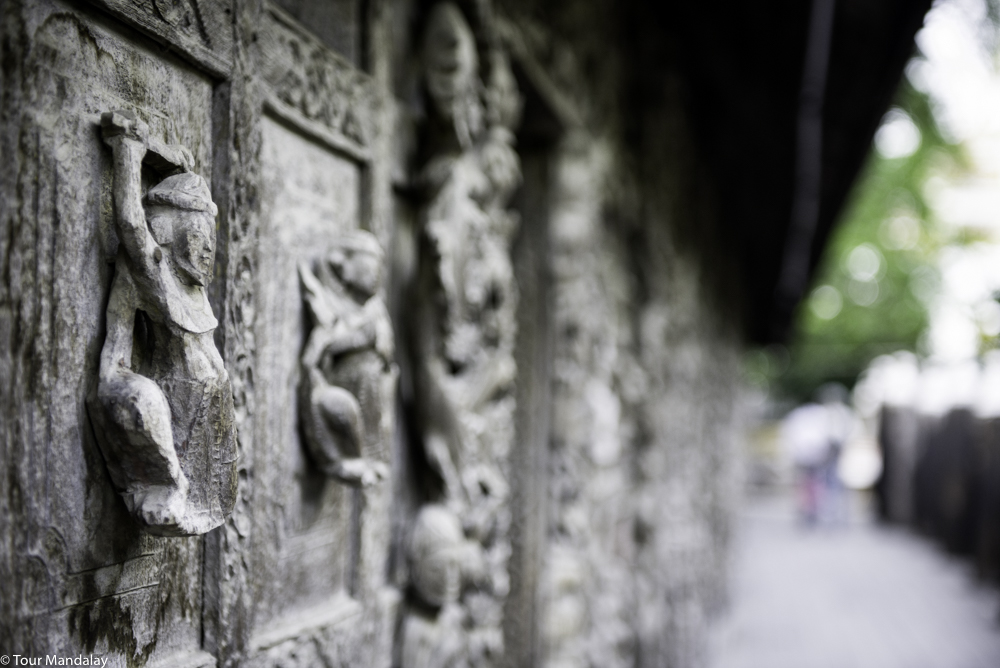
Wood carvings adorn the exterior of the Golden Palace Monastery in Mandalay
Built by the popular King Mindon, Mandalay was the last royal capital of Myanmar, until the British completed their colonisation of the country in 1886. No thanks to neglect and a combination of Japanese and allied bombing, in 1942, the city that had taken a thousand years to build was destroyed within hours. The royal palace, which was moved from the former capital of Amarapura back in 1857, was also burnt to the ground. All that survived was the royal mint, the watchtower and the four 2km long palace walls. Whilst a replica now stands in place, one can only imagine what the grounds and interior of the original palace would have looked like if it still stood today.
Almost as though it has risen from the ashes, Mandalay exists today as a young, lively and vibrant city, famous for its culture, education and arts. This helps to explain the large number of workshops, ranging from gold leaf making to marble and woodcarving. The city is also home to some of the country’s most lively and colourful markets. Mandalay’s gem market for example, is the largest of its kind in the country and a great way to witness the experienced buyers and sellers do what they do best. Then there is the Thaye Zay Station Bazaar, a local market with a difference. The open-air market spans both sides of a railway track, springing to life in the morning when vendors arrive with close to one hundred pop-up stalls. This business is purely temporary however, seeing as the vendors are frequently required to remove their stock to make way for passing trains.
Mandalay is also an extremely important religious centre, with more Buddhist monasteries than anywhere in the country. One of the most impressive however is the miraculously preserved Shwenandaw Kyaung, or Golden Palace Monastery, originally built as the private residence for King Mindon. Shortly after King Mindon’s passing, his son Thibaw often used the building for meditation purposes, but he soon became convinced that it was haunted by his father’s spirit. As a result, Kind Thibaw ordered the building to be dismantled and relocated to an area outside of the palace grounds. If it were not for this superstition, the country would have lost this awe-inspiring piece of architecture long ago.
Nearby, located at the foot of Mandalay Hill, the largest book ever written can be found in the grounds of Kuthodaw Pagoda. King Mindon ordered 729 marble slabs to be inscribed in gold with the entire Buddhist text of the Tripitaka, a remarkable testament to the popular king’s devotion to the religion. However, after the annexation of Mandalay by the British in 1885, it was decided that their troops would be stationed in the city’s monasteries, temples and pagodas. During this short period of time, many of the rare treasures that adorned Kuthodaw Pagoda were looted, including the gold from the inscribed marble pages. In 1982, a long and expensive restoration process started, but it was decided the slabs would be re-inked in shellac. Even though it was not possible to restore the complex to its former glory, there is no denying the magnificence of this complex.
Another worthwhile religious site is the magnificent Mahamuni Pagoda, where a 4 metre tall, 6-tonne bronze Buddha sits proudly enshrined. As a result of many years worth of dedicated worship, the originally bronze figure has now been covered in so much gold that it has lost its original proportion. Another highlight of this impressive temple complex are the worn bronze statues from Cambodia’s ancient Angkor Wat temple, believed by locals to possess magical healing powers.
Back to Tour Mandalay’s destination guide

